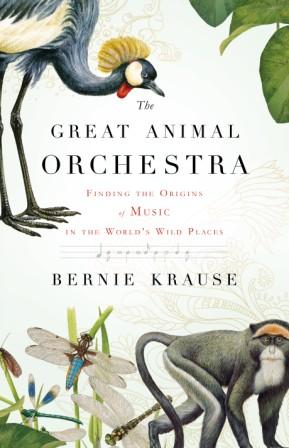
A recording expert ‘hears’ the death
of an ecosystem unseen by his hopeful eye
Musician Bernie Krause, a former guitarist for the Weavers, has been recording and archiving natural environments since the 1970s. Of more than 15,000 species and 4,000 hours of wild soundscapes he has taped, more than half no longer exist in nature. Krause describes some of his findings in this professional autobiography. From the book The Great Animal Orchestra by Bernie Krause. Copyright ©2012 by Bernie Krause. Reprinted by permission of Little, Brown and Company, New York , New York. All rights reserved.
When I was trying to find a single, easy term that would define animal sounds coming from wild places, every expression seemed academic and obscure. In the human realm of noise, the terms were even more obtuse, with phrases such as anthropogenic noise. Nothing quite fit. Then, by accident, I hit on a Greek prefix and suffix that struck just the right chord: bio, which means “life,” and phon, which means “sound.” Biophony: the sounds of living organisms.
In addition to the sonic cues embedded within soundscapes, the biophony as a whole can give us valuable information about the health of a habitat. In an undisturbed natural environment, the richness and content of soundscapes vary from season to season, over time of day, and under different weather conditions. The organic and nonbiological elements that are unique to a location work in a delicate balance, acoustically defining each habitat, much in the way each one of us has his own voice, accent, and manner of speaking.

More than twenty years ago, I asked a biologist working for a large lumber company if I might have permission to record at a “forest management area” in the Sierra Nevada mountains, where his corporation had obtained a lease permit to begin selective logging on public forest land. The site: Lincoln Meadow at Yuba Pass, about three and a half hours east of San Francisco. Bisected by a stream and a bit over two-thirds of a mile long and about a quarter mile wide, the meadow was surrounded by ponderosa pine, lodgepole pine, red fir, white fir, and Douglas fir, as well as a few sequoias. Multiple species of frogs could be heard there throughout the spring. It was a lovely, resonant place. At local meetings held throughout the area, the biologist and his associates assured the community that his company’s new selective-logging methods would have no adverse impact on the habitat. I asked for access to the site to record both before and after the operation. With the company’s blessing, during the summer solstice of 1988 I set up my system in the meadow and recorded an exquisite dawn soundscape expressed by a wide variety of creature sources. Present in the first recording were Williamson’s sapsuckers (a type of woodpecker), mountain quail, chipping sparrows, white-crowned sparrows, Lincoln’s sparrows, ruby-crowned kinglets, and numerous insects.
A year later, after the logging operation was complete, I returned to Lincoln Meadow on the same date, at the same time, and under the same weather conditions to record again. When I arrived I was delighted to see that little seemed to have changed. However, from the moment I pushed the “record” button it was obvious that the once-sonorous voice of the meadow had vanished. Gone was the thriving density and diversity of birds. Gone, too, was the overall richness that had been present the year before. The only prominent sounds were the stream and the hammering of a Willliamson’s sapsucker. I walked a few hundred feet back into the forest from the meadow’s edge, and it became quite apparent that the lumber company had wrought incredible devastation just beyond the meadow’s sight line, where extensive patches of ground had been left exposed. While not exactly a clear-cut, many more trees were taken than had been promised. Over the past two decades, I have returned more than a dozen times to the same spot at the same time of year, but the bioacoustic vitality I captured before logging has not yet returned.
To the easily deceived human eye — or through the lens of a still or video camera — the site even now appears wild and unchanged from the narrow perspective of the meadow. With a photo, we can frame a shot in almost any setting and, depending on what we want to catch in that fraction of a second, evoke responses from awe to horror.
But even a short, unedited sound recording captured in a calibrated and comprehensive way does not lie. Wild soundscapes are full of finely detailed information, and while a picture may indeed be worth a thousand words, a natural soundscape is worth a thousand pictures. Photos represent two-dimensional fractions of time — events limited to available light, shadow, and range of the lens. Soundscape recordings, if done right, are three-dimensional, with an impression of space and depth, and over time can reveal the smallest feature along with multilayered ongoing stories that visual media alone can never hope to capture. A well-tuned ear and attention to minutaie within the larger picture will always uncover any deception.
Whole-habitat recordings of the kind I’ve described illustrate the state of biomes that have been rendered ecologically transformed through human intervention, such as logging or mining; climate change; or natural phenomena, and we can make efficient comparisons — assuming we have well-collected data sets — with audio snapshots as short as ten seconds in length. Like the rings on a tree, these recordings serve as multilevel biohistorical markers. When natural cycles, disasters, or destructive acts of human intercession occur, the events are quickly and powerfully articulated through changes in the biophony. The living collective of sonic organisms responds appropriately. Nonhuman animals will try to recalibrate their voices to accommodate the altered circumstances. The resulting spectrograms either will show far less density and diversity or will appear more chaotic—that is, filled with unrelated or competing information with very little distinction between voices, assuming any remain at all.
We are discovering that the governing features of a biome’s biodiversity are delicately balanced to the extreme. The biophonies of healthy habitats generally fall within a certain expected scope, meaning that given the range of the region’s seasonal climate and the relative stability of the landscape, organisms that typically thrive there should reflect expected numbers of species and total population. What we have noticed is this: Whenever a biophony is coherent, or what some biologists consider “within a range of dynamic equilibrium,” the acoustic spectrograms generated from recordings illustrate remarkable discrimination between all of the contributing voices. On the other hand, when a biome is compromised, spectrograms will lose both density and diversity, along with the clear bandwidth discrimination among voices that is otherwise visible in nonstressed-habitat graphic displays. Biophonies from stressed, endangered, or altered biomes tend to show little organizational structure.
When habitat alteration occurs, vocal critters have to readjust. I’ve noticed that some may disappear, leaving gaps in the acoustic fabric. Those that remain have to modify their voices to accommodate changes in the acoustic properties of the landscape, which may have been altered by logging, fire, floods, insect infestation, or other shifts in the nonbiotic components of the habitat. All of these variations mean that the natural communication system evolved within a soundscape breaks down and becomes chaotic until each creature’s voice once again finds a place in the chorus. This could take weeks, months, or, in some cases, even years. At Lincoln Meadow the biophony at the last visit (2009) remains relatively quiet, with very light density and notably altered diversity, even after almost a quarter of a century of supposed recovery.
